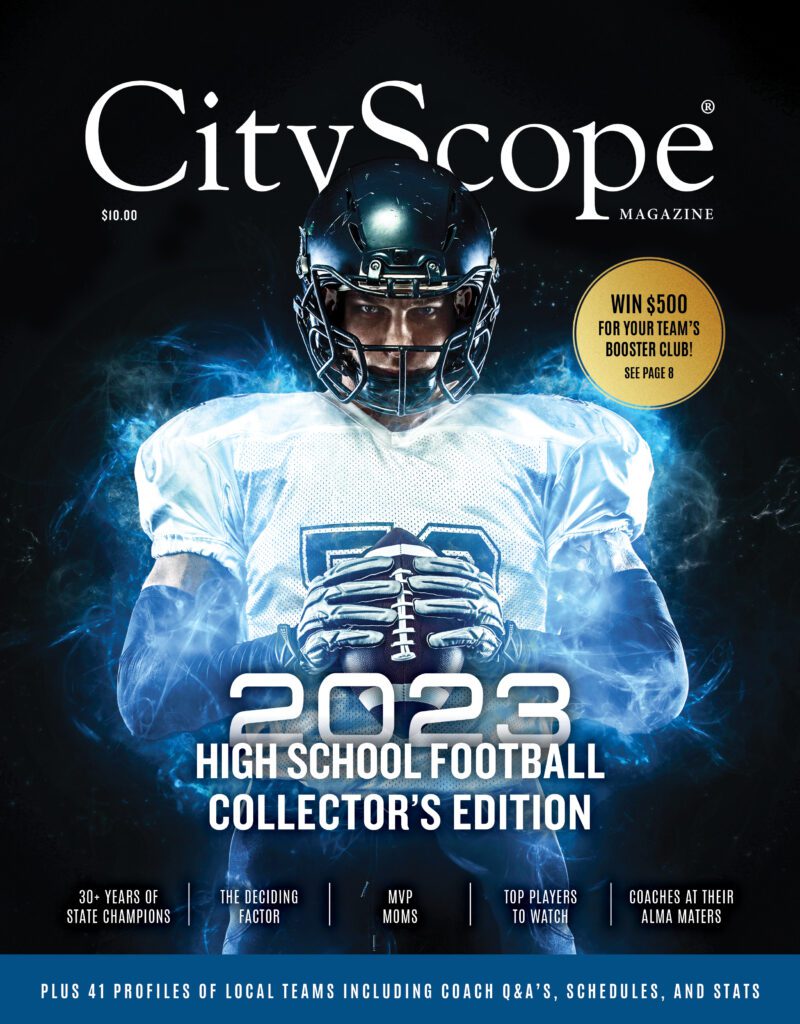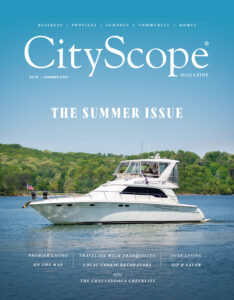What does it take to have a great high school football stadium?
The factors are endless – a storied history, a winning tradition, boisterous fans, community backing, and more. We’re lucky to have top-notch places to enjoy the pageantry and excitement of high school football. In fact, South-
east Tennessee and North Georgia have arguably seen some of the top high school football crowds and atmospheres in the nation. What follows are the top 10 of all time.
Brainerd Rebels
Home Turf: Brainerd High School Football Field
Top Decibel: 1961-1969
Making Room
In the early ‘60s, because of the massive crowds that would attend the games, the administrators at Brainerd would have no choice but to provide additional parking. They did so by taking down the fences and nets at the on-campus tennis courts and creating a makeshift parking lot.
In 1960, the Brainerd Rebels were the new kids on the block. The high school had just begun its now 55-year history, drawing students from the already-established Brainerd Junior High and Elbert Long School. In 1961, when they didn’t yet have a home stadium, the Rebels played their first full varsity schedule, using Engle Stadium for the majority of their home games, and stunned the city of Chattanooga when they went undefeated.
By 1962, a new stadium had been constructed, serving as home to the players, coaches, and the thousands of fans whose hearts were won over in a matter of months. That season, the senior year of the first graduating class, there wasn’t a game that the 7,000 seats weren’t filled with screaming fans. Former players recall that fans would regularly be standing in front of the stands and behind the end zones. The only thing between them and the field was a four-foot fence that was only a few feet from the benches and the back of the end zones. Dr. DeWayne McCamish, an All-City end and team captain at the time, recounts the home field advantage the crowd would bring to their stadium. “The excitement of the crowd and the noise were incredible,” he says. “When we came out of the locker room, you’d have to go through crowds just to get to the end where we would run out, and then it was already packed when we got onto the field. Chills would run up and down your spine as you ran onto the field. The community was so behind us.”
“Winning helped,” McCamish says. “Winning bred winning; it brought more people out to the games.” And win they did. From 1961 to 1969, the Rebels went 72-19-3. Within that span, they won 22 consecutive games from September of 1961 to August of 1963.
Central Pounders
Home Turf: Chamberlain Field Top Decibel: 1948-1967
The history of Central Pounders football in Chattanooga and the surrounding area is rich and dates back to as early as 1907. By the mid-1940s, the Pounders, led by head coach E.B. “Red” Etter, were a perennial powerhouse in high school football, both locally and nationally. More often than not, more than half of their regular season games were played against other highly touted teams that came from outside of Chattanooga. The result was seasons full of unbelievable matchups against dominant teams from all over the Southeast (and sometimes beyond) that would draw Central fans as well as fans simply interested in seeing high school football at its finest.
In 1948, the Central football program began exclusively using Chamberlain Field as their home location. Also the home of the Chattanooga Mocs until 1997, it was naturally awe-inspiring for a team playing at the high school football level. For a high school football player, the stands and lights seemed to be a mile high. The 10,000-plus person capacity could prove to be overwhelming for visiting teams, and at Central football games, it was not at all uncommon for nearly 12,000 fans to be in attendance.
Chamberlain Field seemed to lend itself to a noisy environment. The stands on both sides of the stadium were concrete, so there was nowhere for sound to escape except out of the end zones.
Charles Sedman, who played for Central in the early 1960s, remembers the challenges that the stadium would pose for visiting teams. “When we were out on the field, we heard mostly crowd noise,” he says. “The better, more sophisticated teams had trouble adjusting. I think Steve Spurrier would agree, as he and his teams from Johnson City never completed a pass or scored against Central.”
Chamberlain Field had its fair share of home field quirks, too. To encourage rainwater to drain toward the sidelines and corners of the field, the field was contoured – it was higher in the center by about a foot than it was on the sidelines and end zones. Even still, the drainage wasn’t always completely effective. “The combination of the sloped field and the mud that seemed to always be there in the fall forced the better teams to change their tendencies,” says Sedman. “Coach Etter’s teams always seemed to be the better mudders.”
The Pounders would continue to use Chamberlain Field until 1968, when they began playing their home games at Brainerd. Central High School later relocated to its current location on Highway 58 in 1969.
Cleveland Blue Raiders
Home Turf: Raider Field
at Benny Monroe Stadium
Top Decibel: 1989-1996
The Cleveland Blue Raiders’ tradition of winning dates back to the school’s inception in the mid-1960s. In 1979, the legendary Benny Monroe accepted the head coaching gig at Cleveland, becoming only the third head coach in the school’s history. 18 seasons later, he retired from Cleveland, but only after securing a record of 176-35, three state championships, and a legendary win streak of 54 games. He also created one of the most prolific home field advantages in the state of Tennessee – in his last eight seasons, the Raiders didn’t lose a regular season game at home.
Monroe recalls the stadium having a capacity of between 8,000 and 10,000 seats at the time, which is considerably larger than an average high school football stadium. Specifically, though, he remembers times when ticket sales greatly outnumbered the seats in the stadium. “A lot of the memories I have are the size of the crowds we had at ball games while we were winning big. We had some phenomenal crowds where there were flat-out no seats left. People would line up three or four deep around the track that was in front of the stands to watch the game,” he says. “I specifically remember there were was one game against Bradley in the late 80s where we sold 12,000 tickets at the gate the night of the game, and that was on top of the boosters and season ticket holders.”
On top of remarkable crowds, there were some home field (and sometimes away) superstitions that were put on display at Raider Field. On their way into their home field house after pre-game warmups or at halftime, Monroe’s players were known to only pass by the goalpost on the right side of it. “We’d have someone standing there during games to make sure no one ran on the left side of it,” recalls Monroe. “And if anyone went out on the left side, we’d bring them back out, back around, and have them run back on the right side.”
Dalton Catamounts
Home Turf: Harmon Field at Bill Chappell Stadium Top Decibel: 1961-Present
Long a significant player in the rich history of Georgia high school football, the Dalton Catamounts have one of the most unique Friday night setups in the Southeast. Harmon Field is an off-campus home field to the Catamounts, located about a mile southeast of the school and walking distance to the city center. The school and program supporters have used the location as an asset, creating a college-like atmosphere on Friday nights over the course of several decades and drawing crowds of up to 7,000 people.
Because of the stadium location and community support, the tailgating scene is prolific. On Friday afternoons, the Army National Guard parking lot, which sits catty-corner to the stadium, fills with fans anticipating the team’s arrival. The players travel to the stadium on buses, but before they arrive, they’re intercepted by the fire department, which escorts the buses in with lights and sirens. When they exit the buses, the players and coaches proceed through the Catwalk – where parents, fans, supporters, and the band line up to greet them as make their way into the stadium. “That all plays into getting the players emotionally prepared to play a football game,” says Bill Mayo, an All-State offensive lineman for the Catamounts in 1980 under former head coach Bill Chappell and the current Catamounts offensive line coach. “I don’t think you can discount the effect that has on our guys when we’re playing at home. They always have a little something extra when we’re playing at Harmon Field.”
Unlike many other high school stadiums, Harmon Field doesn’t have a track surrounding it. Instead, the stands are within ten yards of the playing field, placing fans right on top of the action. That can make things difficult for opposing teams, as Catamount fans have been known to use anything from the metal seating to pennies in milk jugs to create thunder-like noise. “The fans are right there and much more a part of the action than they would be if they were separated by eight lanes of track,” Mayo says.
Harmon Field has been buzzing on Friday nights since 1925, reaching new levels as the Catamounts came to prominence in the early 1960s. It seems as though Friday nights in Dalton won’t be quieting down anytime soon.
Howard Tigers
Home Turf: Reggie White Field at Gaston Stadium
Top Decibel: 1959-1967
In the early 1960s, Howard was recognized on a national level as a model for success, both academically and athletically. Led by head coach George “Chubby” James, the football program played a critical role in establishing that successful atmosphere. Winning was a tradition both on and off the field.
In his first season as head coach in 1959, James began instilling a strong sense of pride and passion in his players, the program, and ultimately the entire community. Excellence was the expectation from strength of schedule all the way down to the game-day shoes of the players – if they weren’t shined, that player sat on the bench. At that time, playing football for James at Howard was seen as the ultimate measure of success. Howard had made a name for itself, and people looked up to the players because of it. Kirkland Robinson, a 1962 Howard grad who played offensive guard and defensive nose guard for James, recalls the character and feel of the team. “The guys that came behind us knew that tradition,” he says. “They knew the expectations. They took pride in being on the team and being a part of that program.”
The Howard football team quickly rose to prominence, garnering national attention and instilling a tremendous amount of pride in the community in the process. For that reason, it wasn’t at all uncommon for Gaston Stadium to be overflowing. “It was packed to the gills,” says Charles Isbell, a 1961 Howard graduate who played defensive tackle. “Week-in and week-out it was standing room only.”
Herman Prater, Sr., who graduated from Howard in 1962 and frequented the home games at the time had similar notes about the stellar Howard scene. “The crowd at the game had the mentality that we were going to score on any given play. That’s what the coaches coached, and what the players believed. It was contagious.”
Marion County Warriors
Home Turf: Bill Baxter Stadium
Top Decibel: 1984-1995; 2014-Present
The tradition of high school football in the valley is in many ways unrivaled, and it was molded partially by the Marion County Warriors of Bill Baxter Stadium.
Beginning with the 1984 season, former head coach Ken Colquette led the Warriors on a 139-24 tear over the course of 12 seasons, harvesting four state championships and working fans into a frenzy.
Colquette is quick to point out that the Marion County fan base was a key piece in not only the home games, but on the road, too. “We’d have bigger crowds at away games than the home team,” he says “But at home, there was a track around the field that would fill up about 15 people deep. So needless to say, it was an intimidating experience to play at our place.”
Beyond talent, coaching,
and community, there’s another well-known entity that plays a critical role at Bill Baxter Stadium. That is the Marion County Whistle, which will forever be a Warrior staple loved by their fans and despised by their opponents. A former train whistle, it’s an extraordinarily loud and shrill form of “salt in an open wound” that blares after game-changing plays and proverbial nails in the coffin.
As the program came down from the high of the mid ‘80s and early ‘90s, the piercing screeches of the whistle seemed to be fading into murmurs deep in the county. But with just two home losses in the last three seasons, and a 12-2 performance and state championship appearance in 2014 with current head coach Ricky Ross, the greater Chattanooga area may be hearing that whistle blare regularly on Friday nights in 2015.
Red Bank Lions
Home Turf: Tom Weathers Field at Red Bank Community Stadium Top Decibel: 1988-2000
More than 75 years ago, the Red Bank Lions played their first interschool football game. In 1973, legendary head coach Tom Weathers arrived on the scene and began laying the foundation for a quiet expectation of excellence.
By the ‘90s, the previous decades of high performance had culminated with a hyped-up atmosphere that would overtake the community every autumn Friday night. Fans often described teams during this decade as business-like. Each player was aware of the public perception of the program, and that mentality carried over to the crowd.
Coach Weathers’ son, Wendell Weathers, who currently serves as assistant athletic director and dean of students at Ooltewah High School, witnessed the Red Bank home field advantage and knew it was something special. “The community felt that it was their duty to provide the best atmosphere in our area when it came to home games,” he says. “The stadium was packed, and fans numbered in the thousands. They arrived early and worked tirelessly to create a home field advantage from long before kickoff to when the game ended.”
The tradition of excellence on the field flowed over into the stands to create a professional atmosphere. Fans and boosters took care of the little things – anything from prepping the concessions to postgame cleanup – that collectively create an environment like the one at Red Bank. “That atmosphere is one that you just know the opposing team and their fans notice. Those types of things, even the little things, present a professional image of excellence, and that gets into an opponent’s head,” says Weathers. “That’s what made it such a formidable place to play, and it continues to this day.”
Rossville Bulldogs
Home Turf: Hutcheson-Memorial Field Top Decibel: 1954-1978
The Rossville program was prolific throughout its existence, which spanned from 1932 to 1988. With the help of legendary coaches like Glenn Wade, Frank Fabris, and Lynn Murdock, a winning tradition was established. The Rossville community was tightly knit, and took pride in and rallied around its football team.
In 1954, the Bulldogs claimed their first state championship, which seemingly propelled the program, the spirit, the community, and the crowds to new levels that would resonate for the next two decades.
Murdock, who coached Rossville from 1964 to 1984, recalls a number of games when the crowds packed in much more than the 6,200-seat capacity of Hutcheson-Memorial. “We had a fence around the field,” he recalls. “There was about a yard between the back of the end zone and the fence, and we’d have people right up against it.”
It’s not uncommon to hear that people would not only be standing behind the end zones, but also in front of the stands, directly behind the players.
Rivalry games against Lakeview and Dalton packed the house to its max, drawing crowds of 10,000-plus. “In that 1971 game against Lakeview, I know we had an unbelievable crowd,” Murdock says. “I know because of the ticket receipts that we split with them. We had nearly 10,000 people. And when you put 10,000 in a stadium that holds 6,200, people are going to be standing up, and it’s going to be loud.”
From 1954 through 1978, the Bulldogs’ home field advantage was strong, and the team went 108-31 at Hutcheson-Memorial before things slowed down in the final ten years of Rossville High School’s existence. While the school closed and became a part of Ridgeland High School in 1989, the legendary Rossville home football games rank among the best of all time and will likely not be forgotten anytime soon.
South Pittsburg Pirates
Home Turf: Beene Stadium Top Decibel: 1993-Present
Thirty-two miles west of Chattanooga stands the pride of South Pittsburg High School’s football team: Beene Stadium. On their way into town, visiting teams and fans are promptly made aware of the winning tradition and community-backed football program by the roadside “Welcome to South Pittsburg” sign that marks the city limit and details each of the program’s five state championships. The school and the football program are often described as the heartbeat of the community, and for that reason, Beene Stadium can quickly become one of the toughest environments to play in on a Friday night.
Vic Grider, who coached the Pirates from 1997 through 2012 and has returned for the 2015 season, has been right in the middle of it for more than 15 years. For Grider, South Pittsburg’s 12th man is created by community interest, players buying into the program, and ultimately, winning games. “When you put all those factors together – you get that attitude in the community and you’re playing well and winning games on top of that – the fans can get pretty worked up about it, which creates a very difficult situation for a visiting team to come into,” he says. There’s no question that a winning program creates interest, so it doesn’t hurt that the Pirates have gone 223-60 since 1993, dropping only 21 home games and racking up four state championships along the way.
In addition to a passionate fan base, Beene Stadium itself plays an important role, too. “When opposing teams go in and out of their locker room, they have to walk through a whole tunnel of our people,” Grider elaborates. “In addition to that, we’re one of the few places that doesn’t have a fence around it. There’s a block wall down either side and the ends are kind of open. People lean over that block wall and get pretty intense and pretty close.”
South Pittsburg offers an overflow of the necessities for creating a home field advantage, and Grider wouldn’t have it any other way. “We’re fortunate because our people back us and support us. It’s a great situation here. I wouldn’t trade it for anywhere in the state.”
Trion Bulldogs
Home Turf: Sam R.
McCain Stadium
Top Decibel: 1957-1998
The Trion Bulldogs put their first football team between the lines in 1933. The common factor across the program’s eight-plus decade existence is unity. The coaching staff, players, students, band, and community work as one entity to bring an energy on Friday nights that’s hard for opponents to anticipate or compete against.
The stadium holds about 4,000 people. That, of course, doesn’t count the ones standing between the stands and the fence that rests only yards from the sideline and end zones – and those were the fans that had the most profound impact. According to Tab Gable, who coached the Bulldogs from 1977 to 1981 and 1988 to 1998. “Those fans on the fences, boy, they were tough. They didn’t let you get away with anything,” recalls Gable. “They’d be hanging over the fences on the sidelines and the end zones. They were vocal.” The fan base knew its football, too. It’s well known that the fans knew the importance of each game and pulled through for the team.
The band at Trion during Gable’s career played a critical role for all four quarters. They played right up until and sometimes maybe even a little after the opposing team would break their offensive huddle, which is when, by rule, they were supposed to go silent. “I used to jokingly tell the band director, who’s a great friend to this day, that if we didn’t get a warning during the game for playing while the other team has the ball, then he wasn’t doing his job,” Gable says with a laugh.
Even Spike, the Bulldog mascot, knew when it was Friday and what it meant. He was notorious for lounging in the shade six days a week. On Fridays, though, he would pace and slobber all day in anticipation of the Friday night lights.
More than 15 years later, Trion is still regarded as having one of the most electric atmospheres in North Georgia.





